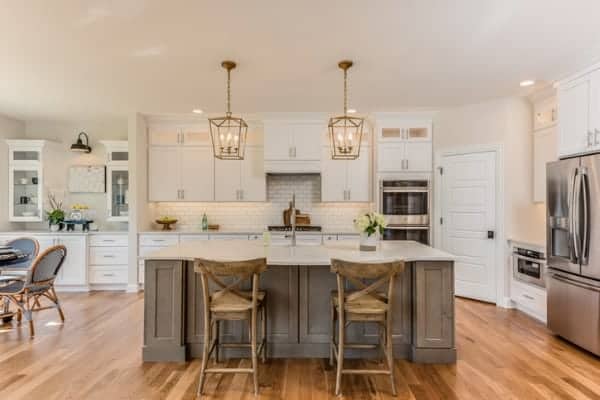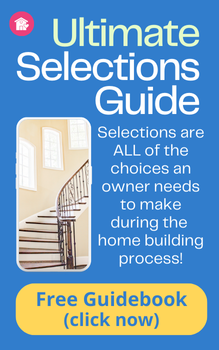Here, I explore other factors related to how you view symmetry or asymmetry in design that are not talked about much, if at all. These are important aspects in design and a quick search online provides numerous articles about these concepts as they relate to home design. I hope this article gives you something NEW to think about.
The ideas explored here actually play a role in how you communicate with others during design talk (especially between spouses or partners). You’ll have countless discussions around the design with your spouse, designer, supplier, architect or builder. These principles will be at play, under the surface. Hopefully, after reading this article, your conversations will be easier!
Internal Design Sensibility
I’ve found in working with numerous clients, and on a personal level, that people tend to have an internal sensibility toward symmetry or asymmetry. When each of us looks at something, we have a sense about whether it’s right (or not). Most of us don’t even think about it because this sense we have is so natural to us. In truth, there is no ‘right’ way, especially when it comes to houses because they are a mix of both. It’s interesting how houses blend different styles to suit everyone’s taste and to make each place special.
Let me give you an example of what I mean.
On a visit to my family’s house, I saw four candles on the fireplace mantel, two on each end, arranged exactly the same. My sensibility was along the lines of ‘hmmm, that doesn’t look right’ as I would want three (2 on one end, 1 on the other). I asked my sister-in-law to play with me about this as a thought experiment.
I went over, removed one candle. We stood back and I asked her what she felt. She had an immediate ‘No, that’s not the way it is supposed to be! They HAVE to match’. She immediately went over and put the candle back in its proper place.
She has more of a symmetrical sensibility and I’m more of the asymmetrical type.
Recognizing that we each have a bias toward one or the other explains a lot! Next time you find yourself talking about design, whether it’s with your spouse, architect or builder, see if you notice the differences in personal sensibility. This is NOT the same thing as congruent or incongruent design principles.
You may want to read that article here: Design Ideas You Probably Never Thought Of
Another example is the super open floor plan, common in today’s homes. You walk in from the foyer and see—the living room, the kitchen, breakfast or dining area, all at once. In the kitchen, there is an island, with a sink in the exact center, opposite the stove. A centerline axis is created between the stove, sink and center of the island.
If the designer had been really strict about symmetry, then whatever is on the opposite wall from the kitchen (probably a fireplace in the living room), it would perfectly line up on this axis.
What’s not to like about that? It is balanced, looks proper and is in order. Unless you have an asymmetrical sense, then maybe it is too perfect?
There are other factors that play into what looks ‘right’ in addition to symmetry.
Functional Use of Space
Some of us look at a space in a house, and what we immediately see is how well it functions (or not).
I’ve had many discussions with friends about the design in their home, because I like to ask these questions. One instance while standing in my friend’s kitchen (of a home she’d bought, not built), I asked her how she liked the design. Well…that was an earful. She had tons of ‘why is the pantry so far from the sink, why is there no overhang on the square island, why square, I would have made a rectangle, I would never have put the cooktop there, with such little counter space on the left side…on and on.’ All of it related to the functional use of the kitchen. Function over form.
Let’s use the example of a sink centered in the island with the stove/range hood lined up exactly on the same axis.
If you are someone who has this functional use mindset, having the sink centered on the island exactly opposite the stove is NOT foremost in your mind. You might dislike the crowded feeling of the sink/stove area. I have lived with that and don’t like it. When two people are cooking together, it feels awkward standing back to back: one working at the stove while the other is at the sink.
Also, I don’t want my sink, of all things, to be the focal point of my kitchen! Mine is not always neat and clean. I’d prefer it off to the end of an island or somewhere else entirely. One solution is to simply move the sink a couple of feet over on the island. It wouldn’t line up on that axis anymore. Perfectly fine to my way of thinking. Function wins over form and since I tend toward asymmetry anyway, I wouldn’t give the choice of moving the sink over a second thought.
HOWEVER, if you lean toward design with the classic symmetrical elements, then it might be more important to you for the sink and the stove to line up exactly (and possibly even with the fireplace at the other end of the living room). It would feel ‘off’ and ‘not right’ to you.
Design Invokes Feeling States
Our homes are evocative. We feel countless emotions from them and towards them. During the process of design, we often make decisions based on how it feels to us even when we are not consciously aware of the feeling. During an online search, the following adjectives were used to describe the difference between symmetry and asymmetry. These felt right to me and I share them here.
Symmetrical
On the more positive side: uniform, balanced, formal, ordered, familiar, safe, classic.
On the more negative side: boring, predictable, formulaic, rigid, dated, overused, stiff.
Asymmetrical
On the more positive side: dynamic, unexpected, relaxed, creative.
On the more negative side: risky, chaotic, off-balance, unpredictable, not safe.
Symmetrical is easier to do (classic). Asymmetry is a little harder to pull off properly.
Color is also another MAJOR factor in evoking emotions. There’s even a thing called color psychology.
As a practical matter, great home design will be the “perfect” mix of all of these elements to create a home that functions well while also being beautiful, harmonious and having a ‘just right’ feeling for everyone.
Happy designing!
This guidebook is 20 pages long and can save you tons of time and money. In it, you'll find some very unique ideas. Click here for Free Guide to Making All of Your Selections Hope this helps and happy building! Julie You've got this! Remember..
of what you want and how you want it done.


